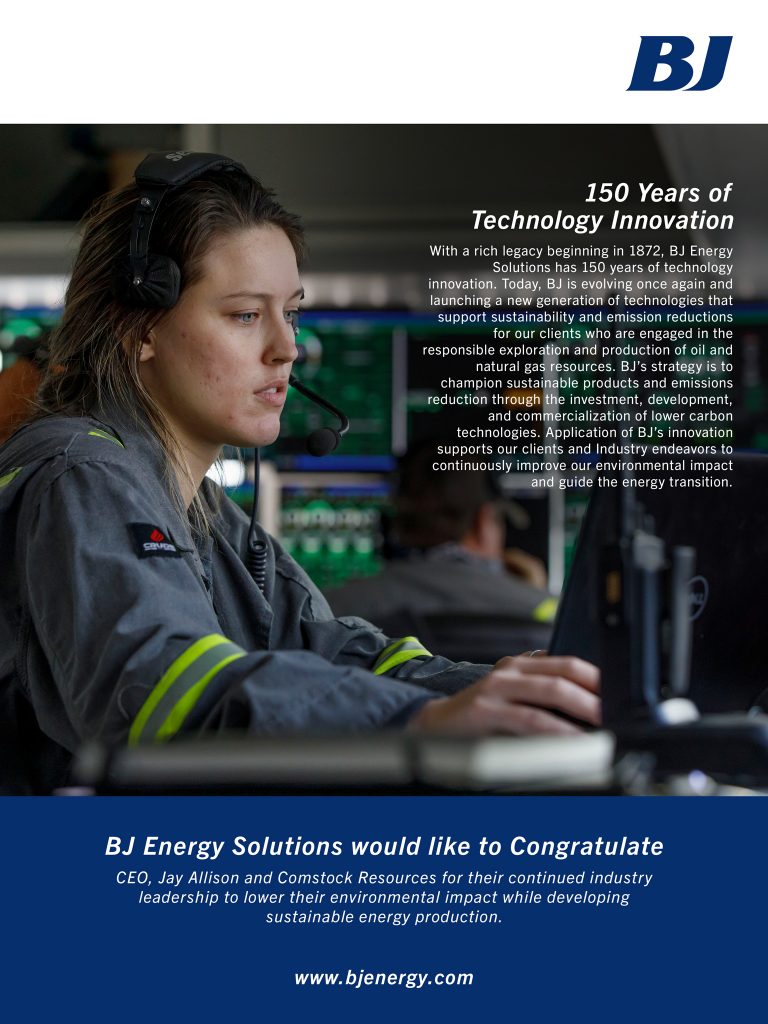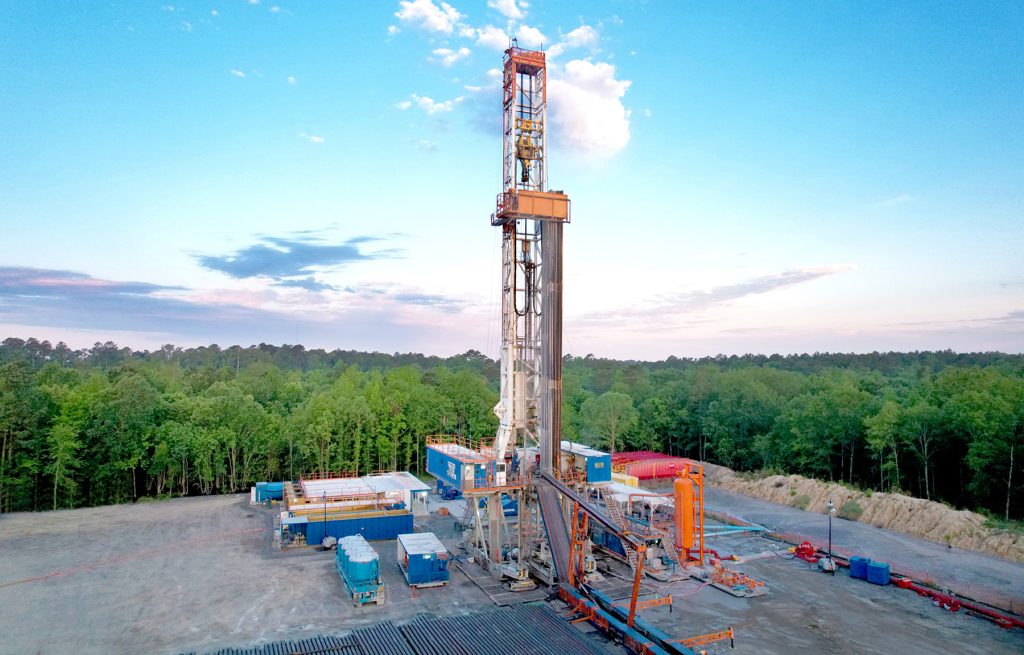Language
You can read the magazine in one of the following languages
Looking back over the past 35 years, M Jay Allison, Chairman and CEO of Comstock Resources, has survived in the high-stakes oil and gas industry where hundreds of companies have not made it.
He’s lucky, he says, but perhaps solid management and an open eye for opportunity played their parts as well. Regardless, Jay has steered Comstock Resources to solid ground and a promising future. “It’s almost miraculous for us to be in existence for this length of time and so well positioned in an environment that needs natural gas,” he explains.
Comstock Resources is an independent natural gas producer with operations based in the Haynesville shale in North Louisiana and East Texas. The Haynesville shale is one of North America’s premier natural gas basins and is located near the liquidated natural gas (LNG) export hub along the US Gulf Coast. Today, the US exports about 12 billion cubic feet a day in the form of LNG, and exports another seven billion cubic feet a day to Mexico.
We’ve been through at least seven boom–bust cycles at Comstock, and we have emerged as one of the top 10 natural gas focused companies in North America.
Jay, a native of Texas, is one of its longest-tenured CEOs in the oil and gas industry. He earned his undergraduate degree, master’s degree in economics and his law degree at Baylor University, then worked at law firm Lynch, Chappell & Alsup representing oil and gas companies for about five years.
In 1987, at the age of 30, he acquired Comstock Tunnel and Drainage, based in Virginia City, Nevada, which had subsidiary operations dating back to 1863. Named after the famous Comstock Lode, it owned an old silver mine and real estate in Nevada. Jay renamed it Comstock Resources and changed the business plan to acquire and drill oil and gas properties. He has been a director since 1987, CEO since 1988, and was elected Chairman of the Board of Directors in 1997.
The ups and downs associated with growing from a small startup to the phenomenally successful business Comstock Resources is today took substantial endurance; something which Jay is no stranger to, having been an accomplished ultra-marathon runner. Just as he embraced the challenge of the races, so he has embraced the challenge of surviving and thriving in the challenging and ever-changing oil and gas industry in North America.
Over the years, Comstock has adapted to meet the challenge of a modern energy company. One that is low-cost, efficient and focused on good environmental stewardship. While it started out as an acquisition company purchasing properties from both private and large public ventures, it later became an explorer using 3D seismic technology to find new reserves in South Texas and the Gulf of Mexico.
When the shale revolution took hold in North America, Comstock became a shale producer in the Haynesville, Eagle Ford and Permian shale plays. After oil prices collapsed in 2014, the company focused on becoming a low-cost natural gas producer. To get there, it had to revitalize the Haynesville shale play, which had been left behind with the emergence of the Marcellus shale.

“This is our 25th anniversary as a listing on the New York Stock Exchange,” Jay says. “We’ve been through at least seven boom–bust cycles at Comstock, and we have emerged as one of the top 10 natural gas focused companies in North America. When oil prices collapsed in 2014, we repositioned Comstock away from oil, and we are over 99 per cent natural gas and have access to the best natural gas markets in North America.”
Comstock was one of the pioneers in discovering the Haynesville shale in East Texas and North Louisiana in 2007. The play lost steam after five years of growth when natural gas prices fell and crude oil prices soared. Comstock, like many companies, invested less in natural gas and moved into the Eagle Ford shale and Permian basin to be oilier.
“We employed new technology which was used in the oil shales to make the Haynesville shale more prolific,” Jay points out. “We were the only public company in 2015 that returned to the Haynesville with extended lateral and enhanced completion wells.”
The return to the Haynesville allowed the company to rebuild and gain the attention of Dallas billionaire Jerry Jones. The owner of the Dallas Cowboys invested US$1.1 billion in Comstock to allow it to accelerate its Haynesville drilling program and to acquire privately held Covey Park Energy.
We also have the lowest costs and the highest margins in the industry.
“Comstock now has one of the largest acreage footprints in the Haynesville shale – 323,000 acres with over future 1,900 drilling locations,” Jay says. “We also have the lowest costs and the highest margins in the industry. The large drilling inventory allows us to grow organically and the high margins allow us to generate meaningful free cash flow to pay down our debt and start paying dividends again in 2022.”
Jay’s evident pride in the company’s stature in a volatile industry is built on its performance through tough times and its longstanding reputation. “To anybody we’ve ever borrowed money from, we have repaid 100 cents on the dollar from day one. That seems like a normal statement, but in the world we’re in and with all the bankruptcies we’ve seen in this cycle, not a lot of companies can say that,” he reveals.
“We are a leader in our basin, and we’re the best positioned natural gas producer with access to the growing natural gas demand along the US Gulf coast. If you look at the 100 rigs that are right now in drilling for natural gas in North America, 50 of those rigs are in the Haynesville. Jerry Jones owns the most valuable sports franchise in the world, and he said over and over, ‘I think that my position in Comstock in the future has the potential to be worth more than my Dallas Cowboys.’”

While the onset of the COVID-19 pandemic took casualties and caused business failures, Comstock was able to work with minimal interruption. “We didn’t have to lay anybody off during the COVID-19 pandemic,” Jay confirms.
Before the pandemic, natural gas prices had been the victim of oversupply. This was partially due to the growth in associated gas from the Permian basin. Once the pandemic set in, oil prices collapsed as transportation demand fell rapidly. The industry pulled back activity and the number of rigs drilling for oil and natural gas fell by 69 per cent.
This drop in drilling activity corrected the oversupply of natural gas. Given natural gas is not used for transportation, demand did not fall off as much as the demand for oil. With a more promising outlook for natural gas producers, Comstock was able to raise US$1.05 billion of capital during 2020 which increased its financial liquidity from US$150 million to more than US$900 million.
In 2021, the company has been able to refinance its higher-cost debt and issue over US$2 billion new bonds with substantially lower rates, something which has saved Comstock US$48 million a year in interest expense.
Now, as the world rapidly pivots to renewable energy sources, Jay is confident Comstock’s fossil fuel future is still assured for a while yet. “We believe natural gas has an important role to play in the energy transition,” he says.
“Responsibly sourced gas from the dry gas plays in North America like the Haynesville and Marcellus shales can provide a low-emission alternative compared to coal, oil and even the associated gas produced in the Permian basin. The production and use of dry natural gas results in substantially lower CO2 emissions than other fossil fuels.
“Reducing methane emissions associated with natural gas is the goal of responsibly sourced gas. We recently partnered with MiQ to independently certify our natural gas operations in the Haynesville shale with regard to methane emission intensity and we engaged a third-party auditor to annually certify our gas under the MiQ standard. This will give the purchasers of our natural gas assurance that we are supplying a low-emissions fuel to help them meet their environmental goals.”
Now that the industry is focused on drilling discipline as public investors look to a return on capital and not production growth, Comstock is well positioned to deliver with the industry’s lowest cost structure and a large inventory drilling prospects.
“As we reduce our debt leverage ratio down to under 1.5 times, we plan to reinstate a stockholder dividend that we had to suspend in 2014,” Jay explains. “We have become investible, we’ve become predictable. We are profitable.”
